Manatee Island
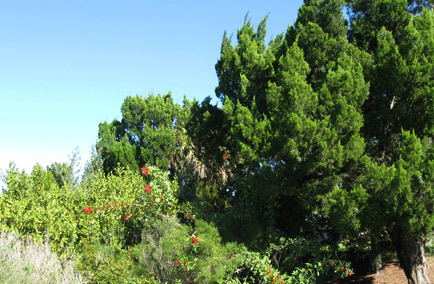
As my last post for the year, it has been a beautiful year for observing nature and tracking conservation efforts here in Florida. Yesterday’s trek to Manatee Island Park located in the Halifax River (a part of the extensive Intracostal Waterway) proved to be quite spectacular.
Ancient yew trees, contrasted by the red-berried ornamental Brazilian pepper trees, a fairly recent (mid-1800’s) invasive plant import, together with near-freezing temperatures was a grand view in the brilliant sunlight of the waning afternoon. The bright red berries and brilliant green foliage in the forefront are frequently used as Christmas decorations in the warmer regions of the Americas with fruits that usually mature by December.
Btw, the Brazilian pepper tree is a shrub or small tree that reaches over 30 feet in height, typically with a short trunk hidden in a thicket of branches producing a dense canopy that shades out all other plants and provides a very poor habitat for native species. Some trees can live over 30 years and is one of the most aggressive and wide-spread of the invasive non-indigenous exotic pest plants in the State of Florida – infesting over 700,000 acres.
This species invades aquatic as well as terrestrial habitats, greatly reducing the quality of native biotic communities in the state. As a Prohibited Aquatic Plant the law prohibits sale and or movement of this species.
Have a happy, healthy, and joyous New Year 2010!
Tropical Flight
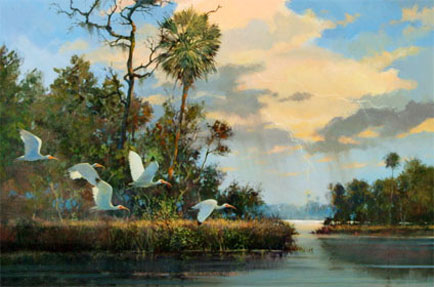
Pictured above are Ibises in flight… other-wise known as “Florida Chickens”. They were most bountiful here, but because of loss of habitat their numbers have dwindled considerably. They can be found where ever there is water. Even if there is just a puddle of water, you will usually see a beautiful white bird.
Other Tropicbirds are slender white birds of tropical oceans, with exceptionally long central tail feathers. Their long wings have black markings, as does the head. There are three species world wide, three North American species, and two Florida species.
Here in Florida we have many coastal seabirds include Gulls, Terns, Kittiwakes and Skimmers as well as others that plunge-dive for fish like Gannets, Boobies, Pelicans, Cormorants and Darters.
The most spectacular of large sea-birds usually found over the Florida tropical ocean are the Frigatebirds that do not swim or walk, and cannot take off from a flat surface but having the largest wingspan to body weight ratio of any bird; they are essentially aerial, able to stay aloft for more than a week. There are five Frigatebird species worldwide, three North American species, and one Florida species.
As well, wading birds are a favorite of photographers like the Flamingoes, Bitterns, Herons, Egrets, Storks, Spoonbills, Cranes, Stilts and Avocets which abound although many are considered on the endangered species list.
Butterflies Abound All Year
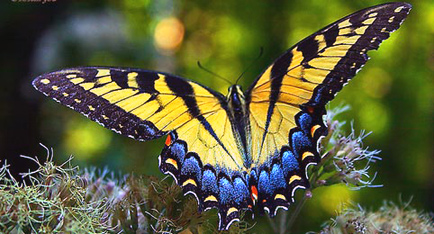
Many butterflies are found in Florida all year in diverse habitats. This tatered Eastern Tiger Swallowtail flies March to November in all of Florida, except the Keys, and is rare in Dade County. This one was seen near the edge of a deciduous broadleaf wood near a woody swamp, where it flew low and fast through shaded areas or the forest edge feeding on the nectar of various bright colored flowers including wild cherry and lilac; drinking on mud.
Btw, the larvae feed on wide variety of trees and sometimes shrubs such as wild cherry, yellow poplar and ash.
This species does not require conservation, unlike the Schaus Swallowtail (in an earlier blog entry) a rare Florida native which is an endangered species that prefers to fly higher, about the tree canopy, whose habitat is found more south of us in more tropical wooded areas like in southern Dade and the Keys.
Forever Green
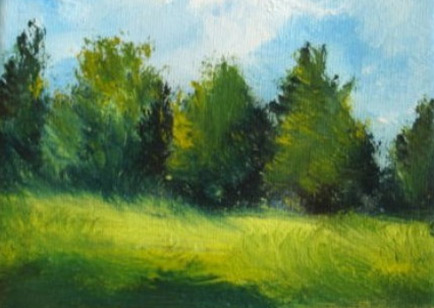
Foregoing the discussions on greenification and energy independence, in art-speak we know that here in Florida, the color green found in nature can have a multiple of no less than 9,142,857 shades and hues. This is so evident when you really look at a stand of trees and shrubs set on a mantle of grass. And, how many grasses grow here in FL!?
There is an abundance of different types of Florida palm trees and shade trees that grow well here, as well as flowering trees, cypress trees and fruit trees. Oak trees, ash trees, tulip poplar trees, and weeping willows found at water’s edge are exquisite shade trees.
The Florida state tree is the Palmetto Palm that grows up to 80 feet tall on a straight trunk with a short rounded crown of palmetto leaves at the top. The official Florida state soil is called Myakka, a native soil of Florida not occurring in any other state. There are more than one and one half million acres of Myakka (an Indian word for Big Waters) soil in Florida. It is the most extensive soil in the state and a great medium for nurishing our extensive varieties of trees, shrubs, palms, and grasses.
Great for naturalists, and certainly a plein air painter’s paradise!
Salt Marsh Ecosystems – a Florida Heritage
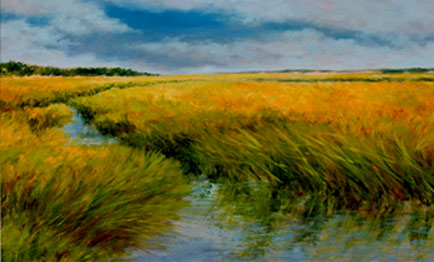
Salt marshes appear as vast dynamic and constantly changing wet lands with fields of grasses; complex ecosystems with various plants like rushes, sedges, and grasses – as well as animals and microbes in various stages of life that all coexist in a fragile balance with their environment and with each other. Salt marshes are important to the estuaries and other coastal waters that surround them as the tides bring sea water into and out of the marsh twice a day. The organisms that live in salt marshes must be able to live in salty water and salty soils. At high tide, the marsh can be completely covered with water. At low tide, it can be completely dry and exposed to the sun. Salt marsh organisms have to be able to live in both wet and dry conditions.
Salt marshes are found on shorelines that are sheltered from ocean waves. Some salt marshes are narrow, fringing marshes and other cover vast acres. They are found on steep coasts, between the water and dry land and salt marshes several miles wide are primarily found near the mouths of rivers, in bays, and in protected lagoons. In some warmer climates, mangrove trees take the place of marshes – which are adapted to both a warmer climate and salt water.
In the Americas these transitional areas are found along coastlines in Florida, South Carolina, Mexico, and in Central and South America – and are considered an important a source of nourishment for many species and a unique and important ecosystem that we must preserve as one of our great natural heritages.
Previous Articles
Welcome to Tropical Conservancy
Thank you for taking the time to visit our blog! Take a second to check out some of our previous posts. You can participate by leaving your comments and helping us to augment our list of resources that hopefully will be a valuable guide to the environmental community and to friends of Florida and Tropical Conservancy, worldwide.


